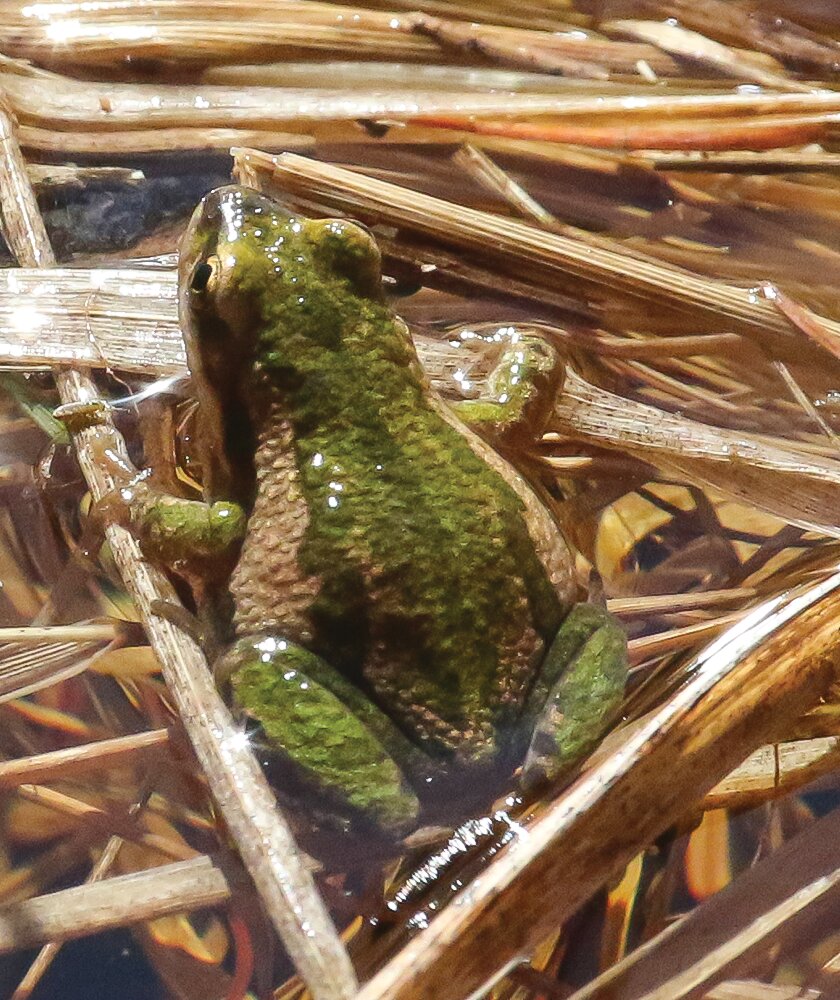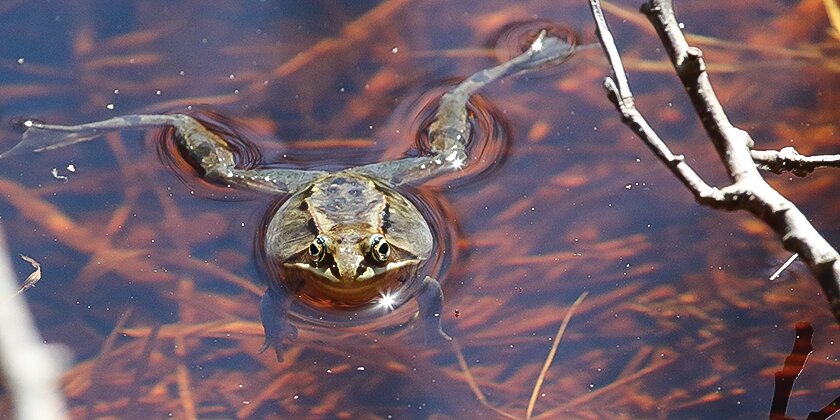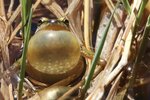Support the Timberjay by making a donation.
The spring chorus
Patience proves key to observing and photographing singing frogs
Here in the North Country, the springtime woods can be a noisy affair, and few sounds are as symbolic of that seasonal cacophony as the calling of frogs. For years, I’ve tried (though …
This item is available in full to subscribers.
Attention subscribers
To continue reading, you will need to either log in to your subscriber account, below, or purchase a new subscription.
Please log in to continue |
The spring chorus
Patience proves key to observing and photographing singing frogs
Here in the North Country, the springtime woods can be a noisy affair, and few sounds are as symbolic of that seasonal cacophony as the calling of frogs. For years, I’ve tried (though apparently not hard enough) to capture images of frogs mid-chorus, but found it can be a challenge.
Turns out, there’s nothing that will halt an amphibious choir faster than attempting to get too close. Like a ripple in a pond, the sound of silence seems to radiate out from me whenever I’ve tried to get in close enough to attempt a photo. And on those rare occasions when I’ve managed to sneak in close, trying to find the source of the incredible sounds emanating from that ephemeral slough can be maddening.
Boreal chorus frogs, one of our most common spring singers, are tiny and their common higher-pitched partners, the spring peepers, are even smaller. But the combined sound they generate this time of year can be deafening.
I recently discovered that the secret to photographing singing frogs is the same as it is for most types of wildlife photography— patience. I paid a visit to an extensive forested wetland east of Soudan recently and a little patience paid off, as I was able to capture some nice images and, even better, observe the world of frogs up close.
It was a windy afternoon, which probably helped since the sound and movement created by the wind, along with my camo gear, helped to mask my careful steps as I worked my way out into the water. While the nearby frogs stopped singing at first, I stood and waited and after a few minutes, they forgot about me and started up again.
Even then, finding the tiny frogs in the midst of the sedges, floating leaves, fallen branches, and other debris, was a challenge until I figured out to stop looking for frogs and start looking for the ripples they make whenever they move. That’s when the frogs started coming into view.
While it was a bright sunny afternoon, normally a quiet time for most frogs, the chorus frogs were irrepressible and it was their persistent singing that prompted me to wade into the swamp with my camera and long lens.
These are tiny frogs, their bodies averaging barely over an inch, but they can generate sounds clocking in at 90-110 decibels, and even louder when large numbers are singing at once.
There are many species of chorus frogs, which includes spring peepers, all under the genus Pseudacris. The boreal chorus frog is found across a wide swath of central Canada down into the central and western U.S., including Minnesota. Like many amphibians, this species is known to be declining, although the causes of that decline are likely complex. They are known to be vulnerable to a virulent pathogen that is spreading globally, affecting amphibian populations everywhere.
Climate change, which has generally led to drier conditions here in the North Country, is likely also impacting frogs as there is less water on the landscape generally.
None of these concerns seemed to be an issue during my recent visit to the frogs. As I ventured further into the swamp, I came across a small, open pool that had attracted at least a dozen wood frogs, which were mostly lounging, just floating on the surface of the water. They’d occasionally paddle or kick their legs, interspersed with their croaking “rick-rick-rick” call which is nowhere near as loud as the chorus frogs. They may have just emerged days earlier from their winter dormancy, during which they are literally frozen solid, but these frogs didn’t seem to be in a hurry. They seemed to be enjoying themselves, just hanging with their pals, being frogs.
Wood frogs are a different genus (Lithobates) than the chorus frogs, and are noticeably bigger as well, averaging about two and a half inches in body length. They’re recognized by their size, their dark brown coloration and the raccoon-like mask around their eyes.
Wood frogs have gotten quite a bit of attention from researchers in recent years because of their ability to freeze nearly solid in winter through a variety of adaptations. Most other frogs find wetlands in the fall and bury themselves in the sediments to avoid freezing, but the wood frog simply burrows into the leaf litter and freezes nearly solid without any apparent damage.
They are also unusually terrestrial for a frog, and will range long distances from water, relying on the dampness of the forest floor to maintain the skin moisture frogs need. They’re known to range widely (at least for a frog), traveling hundreds of meters within their habitats, although always connected to a breeding pond.
Wood frogs are considered to be heavily reliant on ephemeral pools that arise in the wake of spring snowmelt only to disappear in the summer heat. A trend toward more winters like we experienced this year could certainly impact wood frog reproduction down the road. At this point, their populations are considered healthy, and from the look of things from my recent visit to the swamp, they’re kicking back and enjoying life!











